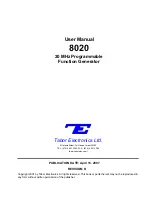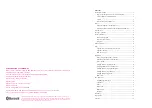
KRAMER ELECTRONICS LTD. 4
1.3 SDI Standards
Today, “uncompressed” digital video usually refers to digital component video (the ITU-R BT.601
standard). This is based on a sampling of component video. The sampling scheme stipulates one
luminance (Y) sample for each pair of color-difference (R-Y and B-Y) samples.
Luminance sampling is done at 13.5MS/s (mega-samples per second), and each color-difference is
sampled at 6.75MS/s. This is also known as 4:2:2 (Y is sampled at 4f
sc
(more or less!), and the color
differences at 2f
sc
).
The 8 or 10 bits of data are serialized to produce a single stream of bits (SMPTE-259 standard) at
270MB/s for 10 bits (10X(13.5+6.75+6.75) = 270). This is known as “Serial Component Video”, and is
usually referred to as SDI.
“Serial Composite Video” is (true) 4f
sc
sampling of composite video – PAL at ~177MB/s, and
NTSC at ~143MB/s. This standard is hardly used, except in some older installations in the USA.
The “Digital Widescreen” standard was launched in the early 90’s. This is a digital version of Pal
Plus (16:9 or Letterbox aspect ratio), and it works at 360MB/s.
1.4 Factors Affecting Quality of Results
There are many factors affecting the quality of signals transmitted from a source to an acceptor. The
following examples illustrate the effect on analog video and audio. For digital signals, interference
effectively decreases “cliff” length.
Connection cables
Low quality video cables are susceptible to interference; they degrade
signal quality due to poor matching and cause elevated noise levels.
They should therefore be of the best quality.
Sockets and connectors
of the sources and
acceptors
So often ignored, they should be of highest quality, since "Zero ohm"
connection resistance is the objective. Sockets and connectors also
must match the required impedance (75ohm in video). Cheap, low
quality connectors tend to rust, thus causing breaks in the signal path.
Amplifying circuitry
Must have quality performance when the desired result is high
linearity, low distortion and low noise operation.
Distance between
sources and acceptors
Plays a major role in the result. For long distances (over 15 meters)
between sources and acceptors, special measures should be taken in
order to avoid cable losses. These include using higher quality cables
or adding line amplifiers.
Interference from
neighboring electrical
appliances
These can have an adverse effect on signal quality. Balanced audio
lines are less prone to interference, but unbalanced audio should be
installed far from any mains power cables, electric motors,
transmitters, etc. even when the cables are shielded.































